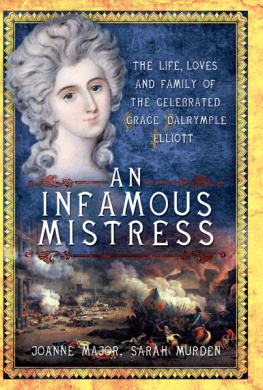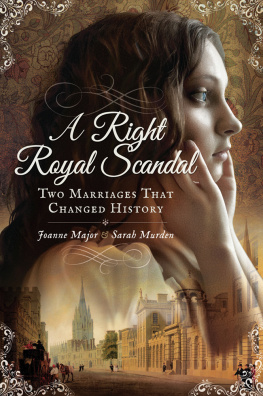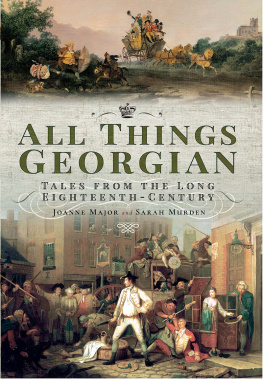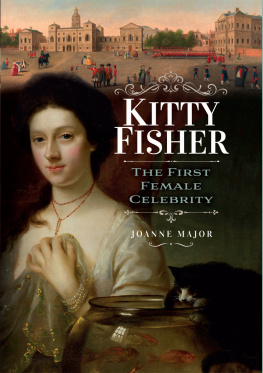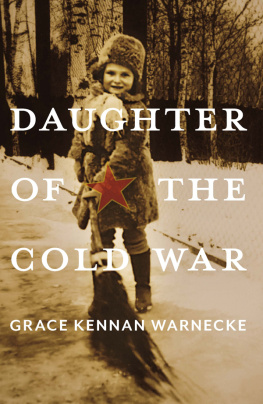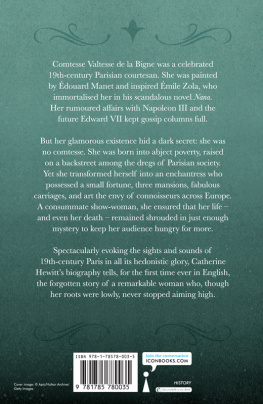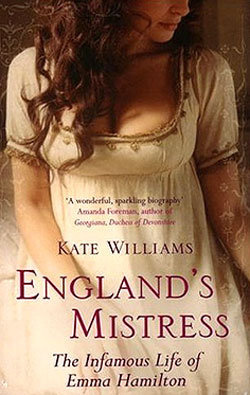First published in Great Britain in 2016 by
PEN & SWORD HISTORY
an imprint of
Pen & Sword Books Ltd
47 Church Street
Barnsley
South Yorkshire
S70 2AS
Copyright Joanne Major and Sarah Murden, 2016
ISBN: 978-1-47384-483-4
PDF ISBN: 978-1-47384-486-5
EPUB ISBN: 978-1-47384-484-1
PRC ISBN: 978-1-47384-485-8
The right of Joanne Major and Sarah Murden to be identified as the authors of this work has been asserted by them in accordance with the Copyright, Designs and Patents Act 1988.
A CIP catalogue record for this book is available from the British Library.
All rights reserved. No part of this book may be reproduced or transmitted in any form or by any means, electronic or mechanical including photocopying, recording or by any information storage and retrieval system, without permission from the Publisher in writing.
Typeset by Concept, Huddersfield HD4 5JL.
Printed and bound in England by CPI Group (UK) Ltd, Croydon CR0 4YY.
Pen & Sword Books Ltd incorporates the imprints of Pen & Sword Archaeology, Atlas, Aviation, Battleground, Discovery, Family History, History, Maritime, Military, Naval, Politics, Railways, Select, Social History, Transport, True Crime, and Claymore Press, Frontline Books, Leo Cooper, Praetorian Press, Remember When, Seaforth Publishing and Wharncliffe.
For a complete list of Pen & Sword titles please contact
PEN & SWORD BOOKS LIMITED
47 Church Street, Barnsley, South Yorkshire, S70 2AS, England
E-mail:
Website: www.pen-and-sword.co.uk
Contents
List of Plates
Acknowledgements
We would firstly like to thank family and friends, in particular Joannes children Luke and Aeron, who have all patiently tolerated us researching, writing and becoming totally absorbed in Graces world.
A special thanks must go to Kate Bohdanowicz, without whom this book may never have seen the light of day; to Pen & Sword for taking a chance with us; and to our lovely copy-editor Pamela Covey who patiently tolerated our love of certain items of punctuation about which we will say no more!
Thanks also to the author Hallie Rubenhold for all her encouragement, support and for being our mentor (for more on Lady Worsley see her excellent biography, reissued as The Scandalous Lady W). We would also like to thank the Marquess of Cholmondeley for all his very kind help and for allowing Joanne, with the help of David Yaxley, archivist at Houghton Hall, to delve into documents pertaining to Grace, and the staff at Houghton who dealt with our numerous emails and telephone calls. Thanks go to Pete Huggins, Pete Jones and Peter Trenchard for taking such excellent photographs; to the Kinloch family for allowing us to use the photographs of Jessy Lawrence Brown and John Kinloch; and to the Earl of Jersey and the Trustees of Radier Manor.
During our research we have contacted numerous archives and libraries throughout the UK, France and the USA and we would need another book to thank them all individually. We would, however, like to give a special thanks to the University of Nottingham Manuscripts and Special Collections who battled with technology to ensure that we were able to access a useable copy of a document previously unread due to its poor condition, which unlocked previously unknown information. Also the Royal Archives for their assistance in providing documents relating to Graces connection with the Prince Regent.
Joanne Major and Sarah Murden, 2016
Introduction
Grace Dalrymple Elliott was infamous as a celebrated courtesan and her reputation as such remains to this very day, with people repeatedly trying to answer questions that remain about her life. For although she left behind her own journal recounting her adventures during the French Revolution, published posthumously by her granddaughter, so much of her life remained in the shadows, unknown and misremembered, with even accredited sources mistaking such basic facts as her mothers maiden name and the real names of both Grace and her sister.
Interest in her continues because she is one of historys strong women; she survived, on her own merits and through her own actions, despite being cast out by Georgian society and present during the Reign of Terror in France, her Journal of My Life remaining one of the few first-hand female perspectives of life in the midst of the French Revolution. Today, her story resonates with women the world over and the life she led, the events she witnessed and the people she knew make for a totally fascinating story. Blessed with stunning looks and exceptionally tall for the era, Grace became notorious when she was publicly divorced by her husband, propelling her into life as a courtesan and a fixture in the eighteenth-century gossip columns.
Her lovers included a duke, an earl and a prince (indeed both the earl and the prince were reputed to be the father of her child). Graces life was not merely about scandal though; there is much more to her story, and to tell it in the context of a woman at the heart of a large extended family, with their examples before her, makes one view her actions in a way not previously perceived. It has long been thought that, as a young girl about to be married, she had no one to turn to for advice, certainly no maternal presence. In fact she had two maternal aunts present in London at the time, both knowledgeable women, fully versed in the ways of their own society and of the world in general: does it still then follow that she was pushed into an unsuitable marriage with no female counsel? These same two aunts had both realized their own positions in society by being mistresses to great men, so what counsel did they give to their niece before and after her own divorce and subsequent career as a demirep?
Little has hitherto been known about either her early life or her old age at the beginning of the nineteenth century, and the documents providing details of these periods of her life have lain undiscovered in dusty files at a variety of archive offices until now. Also largely unknown have been any details of her extended family and parentage, even two of her siblings being neglected. Her paternal family has been noted, although her father has remained a somewhat shady character and his familys claim to be related to the Earls of Stair largely misunderstood, but nothing has been told of her maternal family and it is they who are central to her story, for Grace was just one woman in a strong, matriarchal Scottish family. Better still, her wider family also lived intensely interesting lives and each member has their own story to tell, independent of Grace, although hers is the narrative that binds them all together. Her own actions and decisions become clearer when one understands her family.
The lives of Grace and her family encompass travel across the globe, leaving their Scottish roots behind to journey across the seas to India, the United States, Canada and Europe, covering varied and wide-ranging topics including the abolition of slavery, military action, the French Revolution, aristocracy, illegitimacy and social climbing. Of course, as might be expected, a large portion of the action takes place in London society drawing rooms and ballrooms, with a few scandals along the way. As befits a well-connected family, many famous and well-known faces from the Georgian period tumble in and out of their story; the actress and courtesan Mary Darby Robinson (Perdita), Lord Byron, Beau Brummell and the Prince Regent himself, to name but a few.
We make no apologies for including the lives of Graces maternal and fraternal relatives in full here: their own stories need to be told, even if it means we deviate from Grace herself on occasion, for in knowing them we get to know and become conversant with Graces own private world. However, Grace herself is the central theme and we always return to her. For those already familiar with Graces story, we hope that the inclusion of so much new information that sheds light on her decisions and actions in a way not previously discussed and introduces hitherto unknown brothers, aunts, an uncle, several cousins and grandparents into her story will justify revisiting her. For those who have yet to discover Grace, we can now tell her story more completely than it has ever been told before.
Next page
